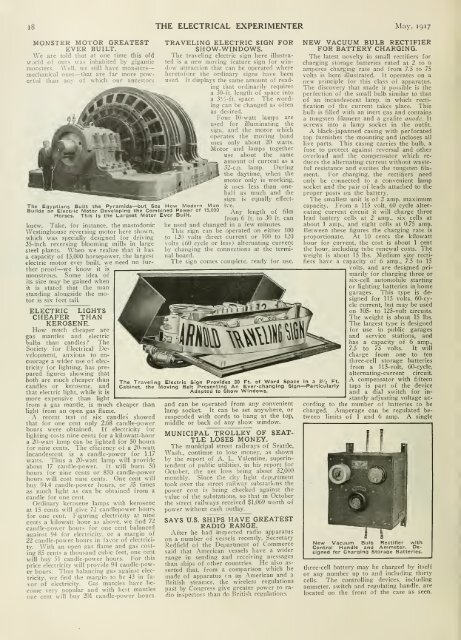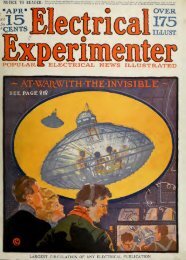The Electrical experimenter
The Electrical experimenter
The Electrical experimenter
You also want an ePaper? Increase the reach of your titles
YUMPU automatically turns print PDFs into web optimized ePapers that Google loves.
i8 THE ELECTRICAL EXPERIMENTER May, 1917<br />
MONSTER MOTOR GREATEST<br />
EVER BUILT.<br />
We are told tliat at one time tliis old<br />
world of ours was inhabited by gigantic<br />
monsters. Well, we still have monsters<br />
mechanical ones—that are far more powerful<br />
than any of which our ancestors<br />
knew. Take, for instance, the mastodonic<br />
Westinghouse reversing motor here shown,<br />
which was specially designed for driving<br />
35-inch reversing blooming mills in large<br />
steel plants. When we realize that it has<br />
a capacitj- of IS.OUO horsepower, the largest<br />
electric motor ever built, we need no further<br />
proof—we know it is<br />
monstrous. Some idea of<br />
its size may be gained when<br />
it is stated that the man<br />
standing alongside the motor<br />
is six feet tall.<br />
TRAVELING ELECTRIC SIGN FOR<br />
SHOW-WINDOWS.<br />
<strong>The</strong> traveling electric sign here illustrated<br />
is a new moving feature sign for window<br />
attraction that can be operated where<br />
heretofore the ordinary signs have been<br />
used. It displays the same amount of reading<br />
that ordinarily requires<br />
a 30-ft. length of space into<br />
a 3'/2-it. space. <strong>The</strong> wording<br />
can be changed as often<br />
as desired.<br />
Four 10-watt lamps are<br />
used for illuminating the<br />
sign, and the motor which<br />
operates the moving band<br />
uses only about 20 watts.<br />
Motor and lamps together<br />
use about the same<br />
—. amount of current as a<br />
32-c.p. lamp. During<br />
' > the daytime, when the<br />
motor only is working,<br />
it uses less than onehalf<br />
as much and the<br />
sign is equally effect-<br />
<strong>The</strong> Egyptians Built the Pyramids— but Se e How Modern Man<br />
Builds an Electric Motor Developing the Com bined Power of 15,000<br />
Horses. This Is the Largest Motor Ever Built.<br />
ive.<br />
Any length of film<br />
from 6 ft. to 30 ft. can<br />
be used and changed in a few minutes.<br />
This sign can be operated on either 100<br />
to 120 volts direct current or 100 to 120<br />
volts (60 cycle or less) alternating current<br />
by changing the connections at the terminal<br />
board.<br />
<strong>The</strong> sign comes complete, ready for use,<br />
ELECTRIC LIGHTS<br />
CHEAPER THAN<br />
KEROSENE.<br />
How mucli clieaper are<br />
gas mantles and electric<br />
bulbs than candles? <strong>The</strong><br />
Society for <strong>Electrical</strong> Development,<br />
anxious to encourage<br />
a wider use of electricity<br />
for lighting, has prepared<br />
figures showing that<br />
both are much cheaper than<br />
candles or kerosene, and<br />
<strong>The</strong> Travelin<br />
Cabinet, the<br />
tliat electric light, while it is<br />
more e.xpensive than light<br />
from a gas mantle, is much cheaper than<br />
light from an open gas flame.<br />
A recent test of si.x candles showed<br />
that for one cent only 2.68 candle-power<br />
hours were obtained. If electricity for<br />
lighting costs nine cents for a kilowatt-hour<br />
a 20-watt lamp can be lighted for 50 hours<br />
for nine cents. <strong>The</strong> efficiency of a 20-watl<br />
incandescent is a candle-power for 1.17<br />
watts. Thus a 20-watt lamp will provide<br />
about 17 candle-power. It will burn 50<br />
hours for nine cents or 850 candle-power<br />
hours will cost nine cents. One cent will<br />
buy 94.4 candle-power hours, or 35 times<br />
as much light as can be obtained from a<br />
candle for one cent.<br />
Ordinary kerosene lamps with kerosene<br />
at IS cents will give 72 candlepower hours<br />
for one cent. Figuring electricity at nine<br />
cents a kilowatt hour as above, we find 72<br />
candle-power hours for one cent balanced<br />
against 94 for electricity, or a margin of<br />
22 candle-power hours in favor of electricity.<br />
With an open gas flame and gas costing<br />
85 cents a thousand cubic feet, one cent<br />
will buy 51 candle-power hours. For this<br />
price electricitj' will provide 94 candle-power<br />
hours. Thus balancing gas against electricity,<br />
we find the margin to be 43 in favor<br />
of electricity. Gas mantles have become<br />
ver\- popular and with best mantles<br />
one cent will buy 201 candle-power hours.<br />
g Electric Sign Provides 30 Ft. of Word Space<br />
Moving Belt Presenting An Ever-changing Sign<br />
Adapted to Show Windows.<br />
and can be operated from any convenient<br />
lamp socket. It can be set anywhere, or<br />
suspended with cords to hang at the top,<br />
middle or back of any show window.<br />
MUNICIPAL TROLLEY OF SEAT-<br />
TLE LOSES MONEY.<br />
<strong>The</strong> municipal street railways of Seattle,<br />
Wash., continue to lose money, as shown<br />
by the report of A. L. Valentine, superintendent<br />
of public utilities, in his report for<br />
October, the net loss being about $2,000<br />
monthly. Since the city light department<br />
took over the street railway substatiuns the<br />
power cost is being checked against the<br />
value of the substations, so that in October<br />
the street railways received $1,069 worth of<br />
power without cash outlay.<br />
SAYS U.S. SHIPS HAVE GREATEST<br />
RADIO RANGE.<br />
After he had inspected radio apparatus<br />
on a number of vessels recently. Secretary<br />
Redfield of the Department of Commerce<br />
said that .'\merican vessels have a wider<br />
range in sending and receiving messages<br />
than ships of other countries. He also asserted<br />
that, from a comparison which he<br />
made of apparatus en an .\merican and a<br />
British steamer, the wireless regulations<br />
past by Congress give greater power to radio<br />
inspectors than do British regulations.<br />
NEW VACUUM BULB RECTIFIER<br />
FOR BATTERY CHARGING.<br />
<strong>The</strong> latest novelty in small rectifiers for<br />
charging storage batteries rated at 2 to 6<br />
amperes charging rate and from 7.5 to 75<br />
volts is here illustrated. It operates on a<br />
new principle for this class of apparatus.<br />
<strong>The</strong> discovery that made it possible is the<br />
perfection of the small bulb similar to that<br />
of an incandescent lamp, in which rectification<br />
of the current takes place. This<br />
bulb is filled with an inert gas and contains<br />
a tungsten filament and a grafite anode. It<br />
screws into a lamp socket in the outfit.<br />
A black-japanned casing with perforated<br />
top furnishes the mounting and incloses all<br />
live parts. This casing carries tlie bulb, a<br />
fuse to protect against reversal and other<br />
overload and the compensator which reduces<br />
the alternating current without wasteful<br />
resistance and e.xcites the tungsten filament.<br />
For charging, the rectifiers need<br />
only be connected to a convenient lamp<br />
socket and the pair of leads attached to the<br />
proper posts on tlie battery.<br />
<strong>The</strong> smallest unit is of 2 amp. ma.ximum<br />
capacity. From a 115 volt. 60 cycle alternating<br />
current circuit it will charge three<br />
lead battery cells at 2 amp., six cells at<br />
about 1 amp., and eight cells at 0.75 amp.<br />
Between these figures the charging rate is<br />
proportionate, ."^t 10 cents the kilowatt<br />
hour for current, the cost is about 1 cent<br />
the hour, including tube renewal costs. <strong>The</strong><br />
weight is about 15 lbs. Medium size rectifiers<br />
have a capacity of 6 amp., 7.5 to IS<br />
in a 3' 2 Ft.<br />
-Particularly<br />
volts, and are designed primarily<br />
for charging three or<br />
six-cell automobile starting<br />
or lighting batteries in home<br />
garages. This tj'pe is designed<br />
for 115 volts, 60-cycle<br />
current, but may be used<br />
on 105- to 125-volt circuits.<br />
<strong>The</strong> weight is about 15 lbs.<br />
<strong>The</strong> largest tj-pe is designed<br />
for use in public garages<br />
and service stations, and<br />
has a capacity of 6 amp.,<br />
7.5 to 75 volts. It will<br />
charge from one to ten<br />
three-cell storage batteries<br />
from a llS-volt, 60-cycle,<br />
alternating-current circuit<br />
A compensator with fifteen<br />
taps is part of the device<br />
and a dial switch for instantly<br />
adjusting voltage ac-<br />
cording to the number of batteries to be<br />
charged. Amperage can be regulated between<br />
limits of 1 and 6 amp. A single<br />
New<br />
Contr<br />
signec<br />
_^JX_i<br />
IT<br />
Vacuum Bulb Rectifier<br />
with<br />
De-<br />
3l Handle and Ammeter,<br />
for Charging Storage Batt eries.<br />
three-cell battery may be charged by itself<br />
or any number up to and including thirty<br />
cells. <strong>The</strong> controlling devices, including<br />
ammeter, switch and regulating handle, are<br />
located on the front of the case as seen.




